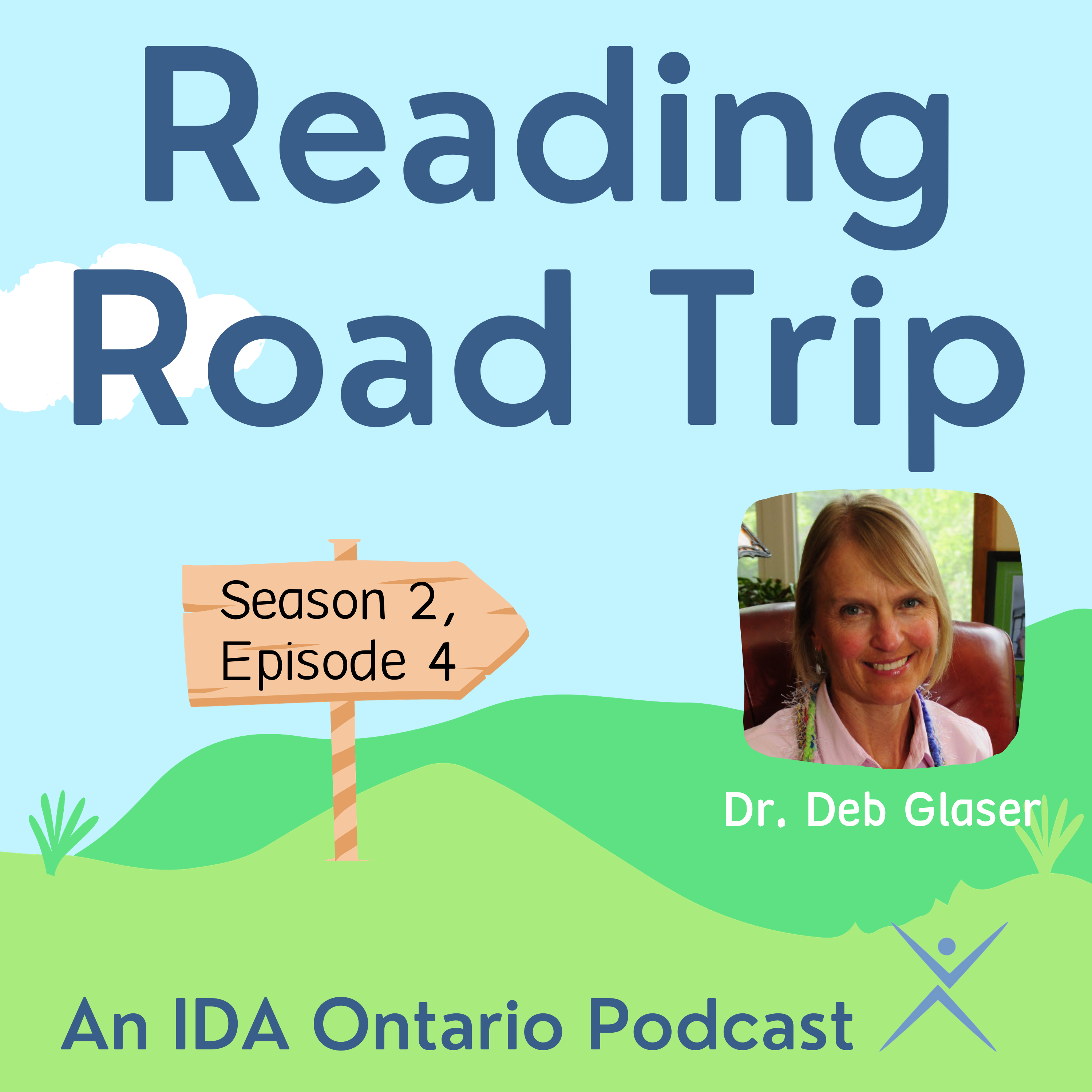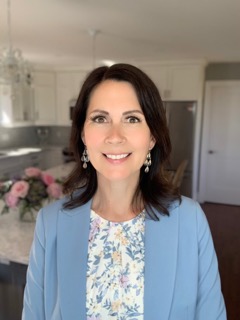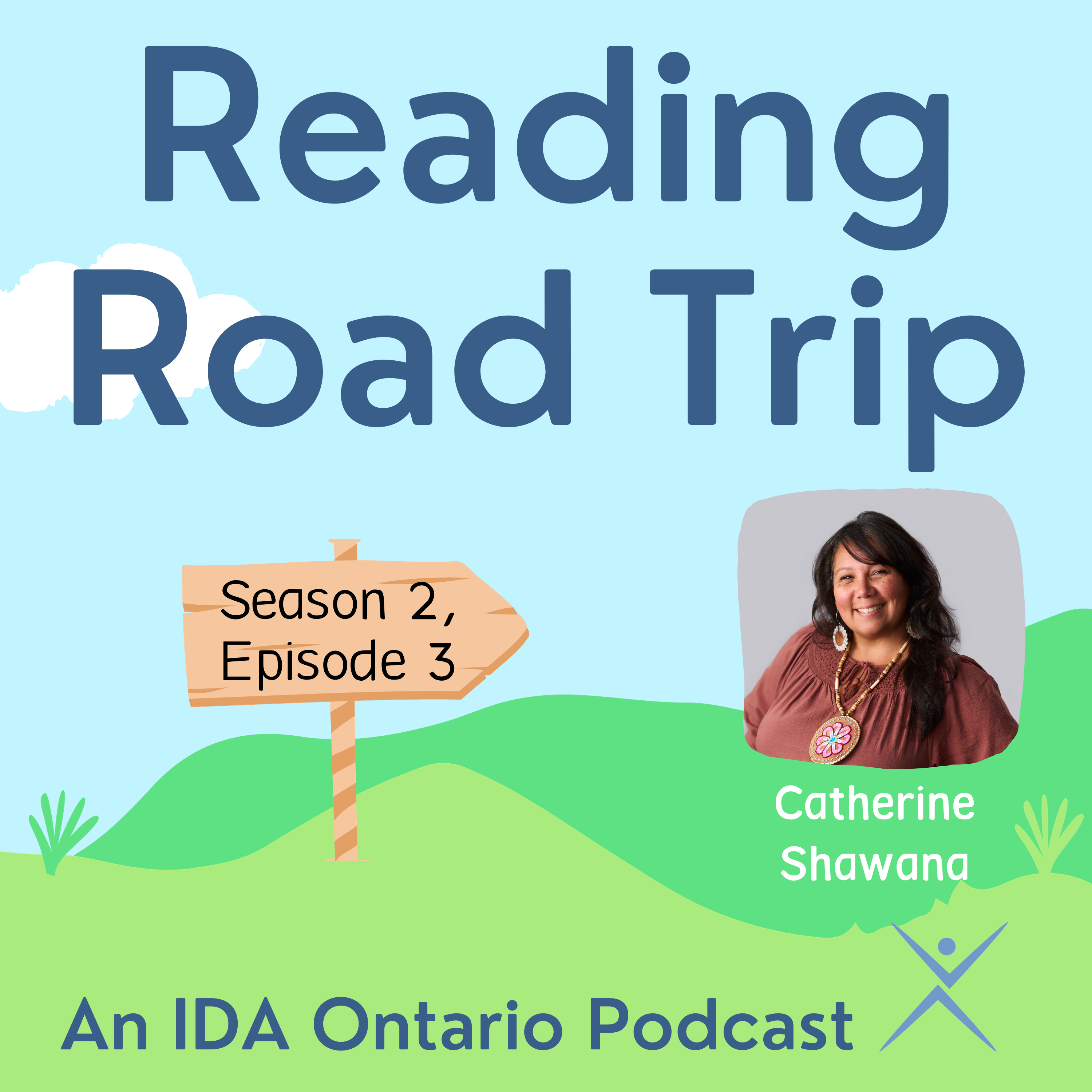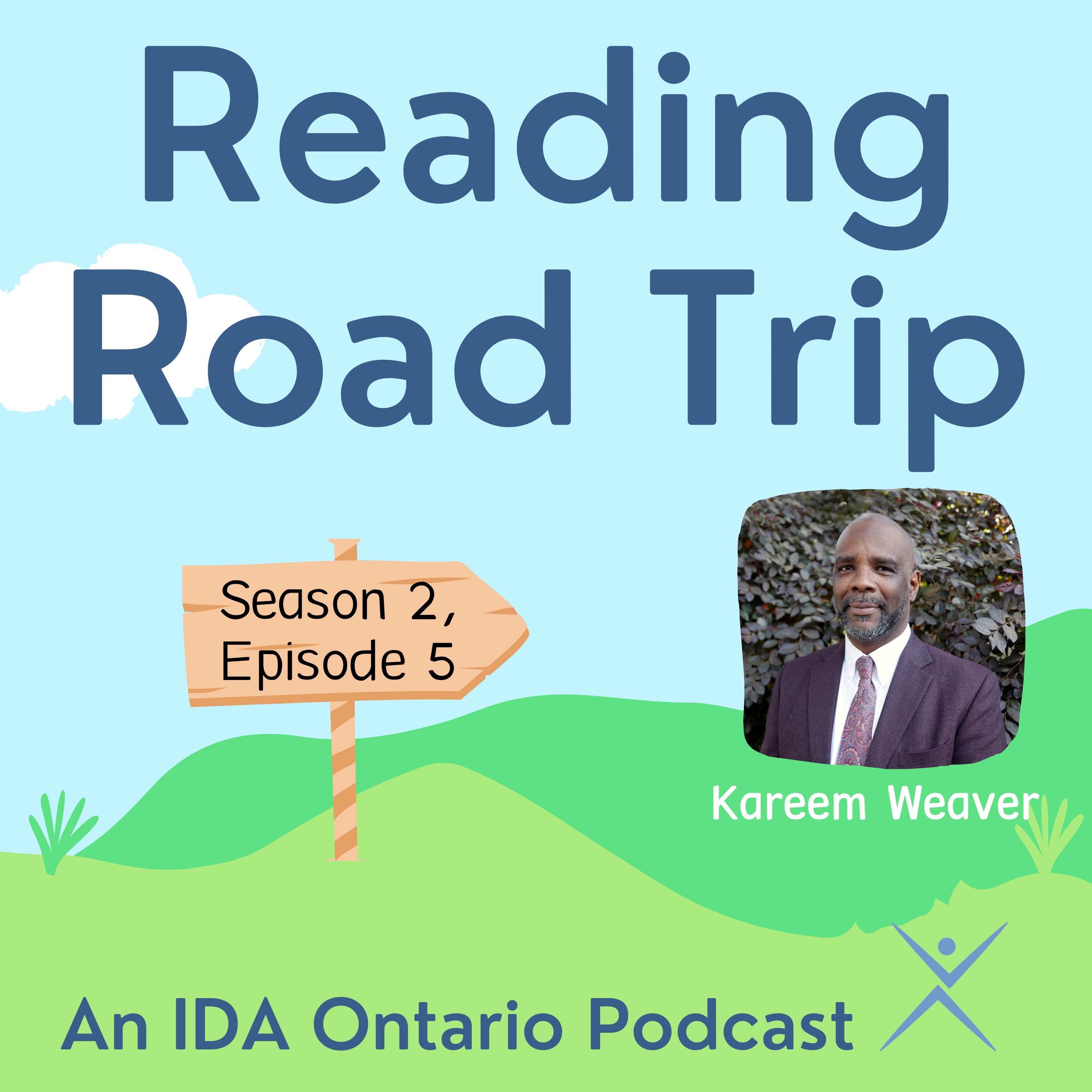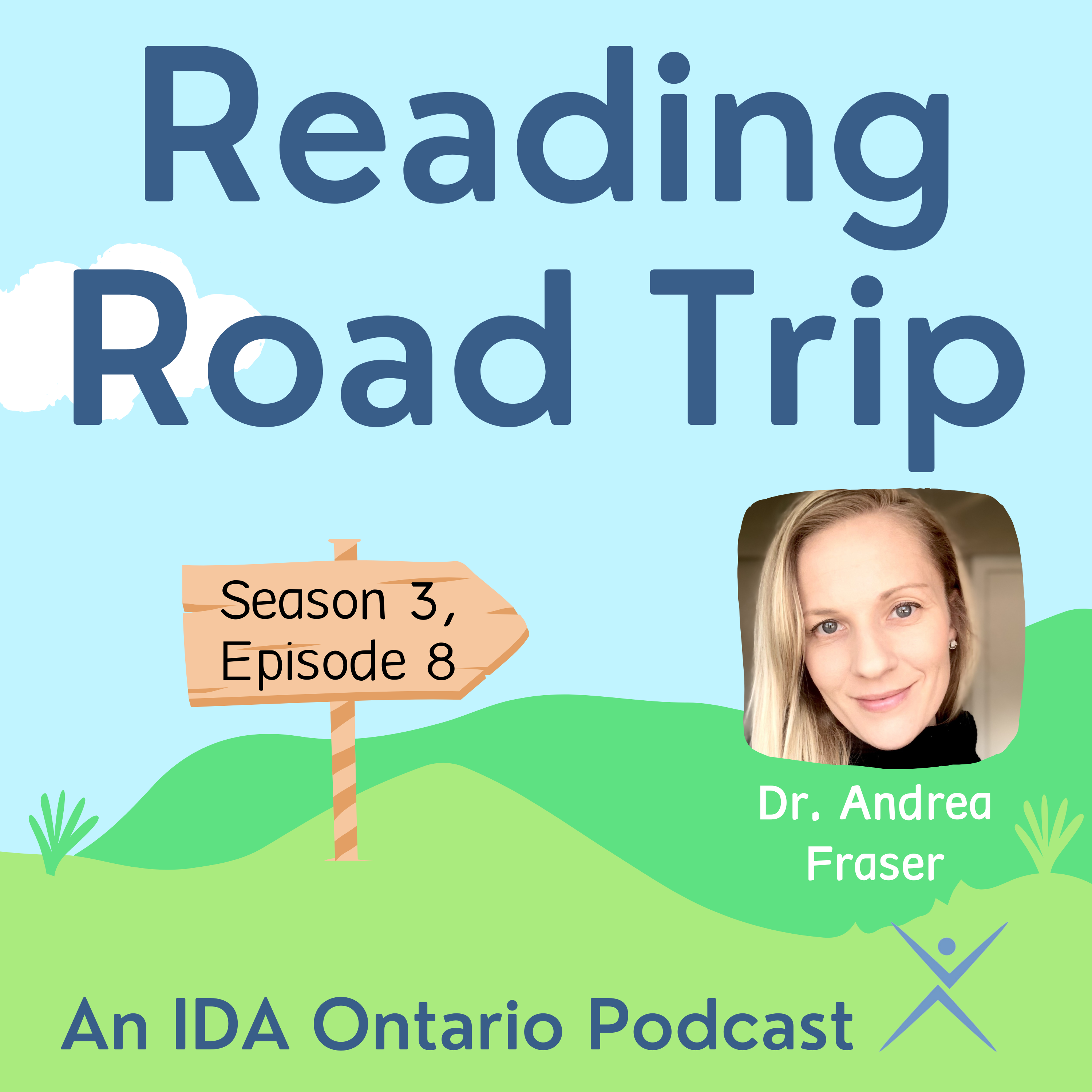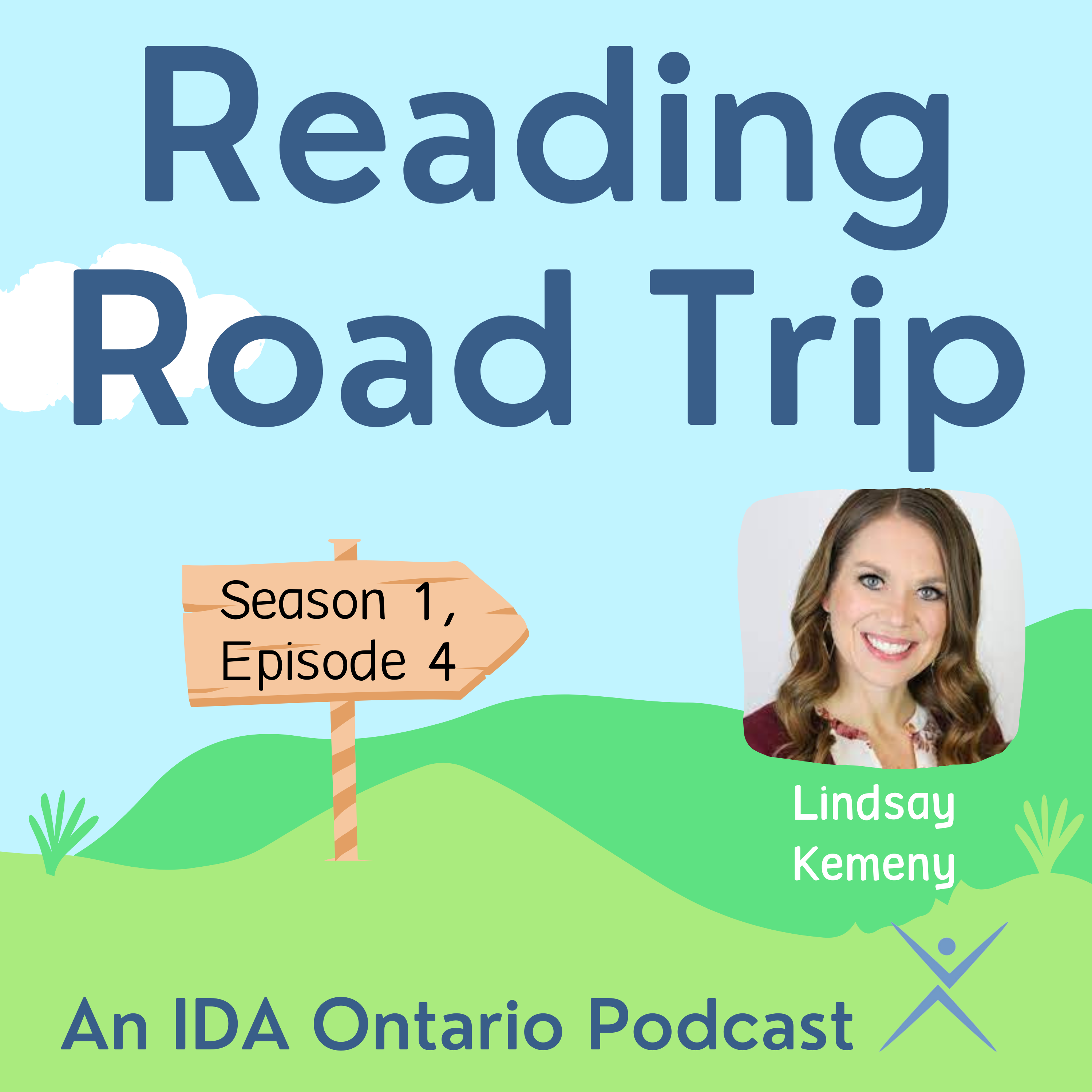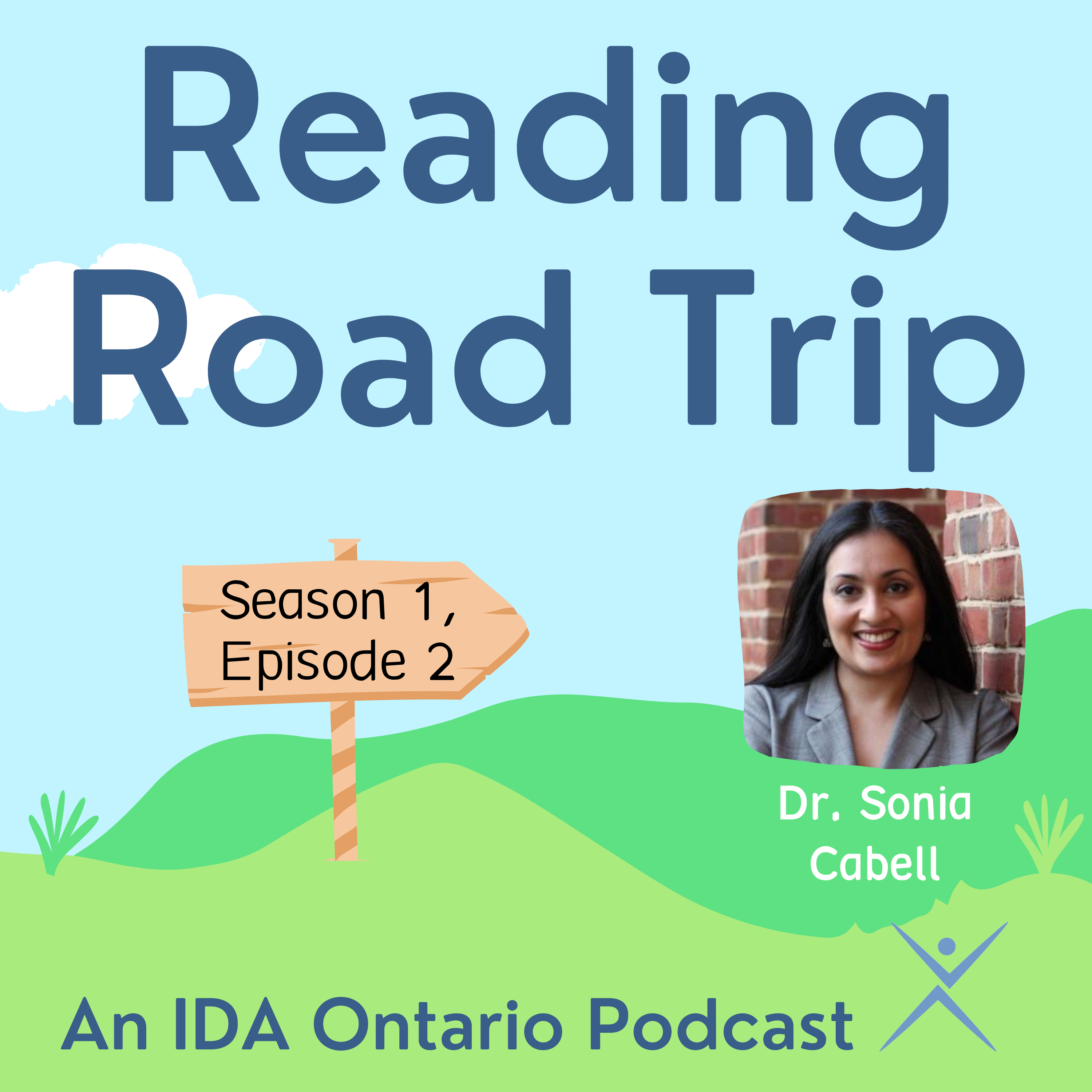Episode Transcript
[00:00:05] Kate Winn: Hello to all you travelers out there on the road to evidence based literacy instruction. I'm Kate Winn, classroom teacher and host of IDA Ontario's podcast Reading Road Trip. Welcome to the show. We are so excited to be bringing you episode four of our second season.
Before we get started, we would like to acknowledge knowledge that we are recording this podcast from the traditional land of the Mississauga Anishinaabe. We are grateful to live here and thank the generations of First Nations people for their care for and teachings about the Earth. We also recognize the contributions of Métis, Inuit and other Indigenous Peoples in shaping our community and country.
Along with this acknowledgement and in the spirit of truth and reconciliation, we'd like to amplify the work of an Indigenous author. And this week we are sharing the picture book Finding My Dance by Ria Thundercloud. In her debut picture book, professional Indigenous dancer Ria Thundercloud tells the true story of her path to dance and how it helped her take pride in her Native American heritage.
At four years old, Ria Thundercloud was brought into the powwow circle, ready to dance in the special jingle dress her mother made for her. As she grew up, she danced with her brothers all over Indian country. Then Rhea learned more styles tap, jazz, ballet, but still loved the expressiveness of Indigenous dance. And despite feeling different, as one of the only Native American kids in her school, she always knew she could turn to dance to cheer herself up. Follow along as Ria shares her dance journey from dreaming of her future to performing as a professional, accompanied by striking illustrations that depict it while bringing her graceful movements to life.
Add this book to your home or classroom library today. And now, on with the show.
[00:01:53] Kate Winn: I am absolutely thrilled to introduce our guest this week here on Reading Road Trip, Dr. Deb Glaser. Dr. Glaser received her doctorate in Curriculum and Instruction with specific focus on reading and school reform from Boise State University. She is an educational consultant, author and professional development provider with expertise in reading assessment and proven instructional methods. She was a classroom and learning disability instructor and director of a nonprofit Dyslexia Learning Center where she developed programs to teach teachers and students. She was an original national LETRS Trainer, a policy advisor to the National Council on Teacher Quality, and regularly contributes to the evaluation of university programs that prepare our teachers to teach reading. Dr. Glaser is author and coauthor of several books and an online reading course, the Reading Teachers Top Ten Tools: Instruction That Makes a Difference, now in the Tools for Reading family, a course that I have taken and which was extremely helpful. I learned so much. And we have Dr. Glaser here to talk about her most recent book with her co-author, Susan Smartt, Next STEPS in Literacy Instruction: Connecting Assessments to Effective Interventions. This is the second edition. So excited to have you here to talk to us about this. Welcome, Dr. Deb Glaser.
[00:03:08] Deb Glaser: Thank you, Kate. I am thrilled to be here as well because I am just so touched by the passion that Canada’s teachers have for updating their processes, their understanding, their knowledge of reading and reading instruction. And it's been a pleasure to work with them over the last several years. And I'm excited to be here with you today.
[00:03:32] Kate Winn: Wonderful. Let's jump right into talking about Next STEPS. So why was it time for a second edition for this book? What's different about this one?
[00:03:42] Deb Glaser: Well, the first edition came out in 2010 and several of the assessments that we focused on in that edition are no longer available or have been updated, have been improved. So from the assessment platform, we really needed to update the assessment piece itself. But along with that, that's 13 years of research too, that has happened and we are much more informed. There's always more to learn. But it was time for a content update, time for a visual update.
Teachers, more and more teachers are on board with wanting to implement processes, methods, instruction, assessment, and I don't know where to begin. And with that in mind, Susan and I just dug into edition one and brought a lot of what we have learned about reading instruction. Also how schools function collaboratively in their work with analyzing, assessment and planning effective instruction based on what they learn from that application of valid and reliable assessments that really give them the information they need to know about their students to plan effective reading instruction.
[00:05:14] Kate Winn: And that's a perfect segue mentioning those valid and reliable assessments. So we know in the classroom practice, we want to start our assessment process with that universal screener, something really high quality. And then we're going to get data from that and we're going to see maybe what we need to change whole group with what we're doing, but we're also going to see what we need to be doing, small group, this targeted instruction, the skills that certain kids need. And that's where your book is extremely helpful. I mean, one thing I would definitely recommend people take a look at page 135, that decision tree for oral reading fluency. I've had so many people ask me, okay, I did my Acadience or I did my DIBELS, and look, I've got it. Okay, now what right? And so that decision tree is extremely helpful. You have this STEPS acronym that can help plan this work, no matter which skill or which kind of area of structured literacy we're working on. So what do those letters in steps stand for?
[00:06:09] Deb Glaser: Well, first of all, yes, it is an acronym, but first of all, the phrase Next STEPS was very purposefully chosen as a title for the book because schools are in the process of taking the next step. Whenever we say, let's take our next step, that means there's movement and progress forward. So there is a symbolism there with the title Next STEPS. And each of you who are listening as individuals, I encourage you to be thinking about as you listen to this conversation what will be my next step? Because all of us are at different places in our knowledge and understanding, our application, our movement forward in this world of the very important work we do. And what will be your personal next step? What will be your next step in it could be reading a research article once a week. It could be working more carefully to implement my very targeted instruction in small group. It might be bringing this into my whole group instruction.
And if that is the case, then STEPS steps would be helpful for you because I worked very purposefully to create a very simplified structure within which teachers could plan explicit and systematic instruction for whatever component is their target focus in small group and also for whole group any teaching we do. So the S in STEPS stands for when you start your startup. This is your warm-up. Just begin, get activating those little reader brains or those big reader brains, if you're working with older kids, with a little warm-up, just some quick review of something you learned yesterday or that they learned last week, a quick word reading, a quick paragraph reading and synthesis of that, for example, it can work in any subject area and any component focus. And then once you do that quick warm-up, move to the T, which is teach, which reminds us as teachers that I am teaching these students something. They need to hear my voice. I need to make it clear to them what it is I am teaching. And then the E is engage. So now let's engage our students in their own application of what I have just taught them. For example, in T, if you taught the grapheme, AI says A in these words and you decoded a few words for them to show them the place for that grapheme in those words. Then in the E Step, the children would take over and you would have your voices combined. It's kind of like an I do, we do, you do routine built into STEPS after Engage, which is also a very brief part of the lesson. Then you move into the dominant focus of the lesson, which is engaging, which, excuse me, is practice. So practicing what you have taught, this could be phoneme-grapheme mapping, it could be applying the decoding of these words into sentences and connected text.
What will be your practice? And that is the element of so much of our instruction with our students that is neglected or passed over, which is that recognition that our students need lots of practice to develop mastery.
So within the Next STEPS book, there are multiple activities then that teachers can very purposefully choose to match what will give their students the best practice with the element that is being taught might be vocabulary words, it might be summarizing in comprehension, writing sentences with a powerful verb. Whatever you're teaching, that practice element is critically important. But leave a little time at the end of your lesson. That final s in STEPS is show you know, and that is a quick brief assessment for your feedback teachers on how well students have learned what you've taught. So it might be you're dictating a few of the words for children to write that they had worked on through their decoding and their practice.
So though, like I said, it's a brief, simplified yet teachers tell me over and over again how helpful it is to them to have that planning guide. It reminds them of the elements of explicit and systematic instruction. The systematicity of the routine is there. So in Next STEPS, in each of the component chapters there are sample STEPS lessons for teachers. So you can see how the steps play out given the focus of your instruction.
[00:11:22] Kate Winn: And the book really is thorough. I mean, as you mentioned, you have practice activities right there depending, as you say, what the focus is, which is fantastic. I love a quote from your book where you and your co-author write “the use of unrelated activities without a connection to goals for learning is no longer an acceptable method of intervention for struggling readers.” And there are so many activities out there. So as I said, if people have this book, then they're set, they can definitely get started. But do you have any tips for people on how to kind of weed through what are maybe the activities we don't want to be bothering with and what are the valuable ones to be using when we are trying to get kids to where they need to be?
[00:12:02] Deb Glaser: That is such a good question and one I think it's important for us to ponder frequently.
We're always looking for the brightest, most fun, cutest and there's a lot out there to choose from that pulls us in and sucks us in.
But are we choosing the activity because it's fun for us or are we choosing the activity because it's something different because we need a change? I think those are really important questions to ask because all we need really are a few very powerful and we know have high utility activities that we could use over and over again. The ones that engage our students in the phonological components of words, the orthographic components of words, the meanings of words toward orthographic mapping and automatic word recognition.
Automatic word recognition including the meaning of the word. So find those few powerful activities, they're in Next STEPS. If you've had my Top Ten Tools, those were the activities that you see in the videos that I created that can be used over and over again. Each activity varies depending on the target skill that you're teaching the students. But it's so easy to get sucked in and we need change, and our students will indicate to us when they need a change too, and do change it up. But we're working toward independency, an independent application of an activity, not something children have to relearn each time we give them an activity. Because we want the learning to be focused on what we are teaching, not how to do an activity. Does that make sense?
[00:14:04] Kate Winn: It really does. And I have to admit, in this age of social media, sometimes I see things online and I think, oh, I maybe should try that, that looks cuter, that looks fun. And even as someone who's very active in posting things, sometimes I'll think, oh, I haven't posted any new cute thing we've done in class in a long time. But then I think we've got our making words that we do and we've got our word chaining that we do. And I mean, it's a cookie sheet. I'm going to use the cookie sheet all year long. So it's really not a great new tweet that I can excitedly share, but it's using those things that we know will work and where the kids know the routines, like you say, and you're not wasting time relearning how you're supposed to do the routine in addition to whatever the new content is. So that's a great point.
[00:14:48] Deb Glaser: Can I say one more thing? I don't want to sound like I'm just no fun because it is, we have to give ourselves a little treat once in a while and the kids and there's nothing wrong with that, but stay true to the routines that we know are the practice routines that will give us the best payback for what our students we want them to master. Yes, and do flavour it up and spice it up, but we all need spice in our lives once in a while.
And yeah, I think some of the strongest research that was done years and years ago was on academic engaged time. And we know that academic engaged time results in learning. The greater time we are focused on and spent thinking about what we are learning, the stronger our learning becomes. I mean, that's just the basic element of memory. We remember what we think about. So build that in teachers into your activities.
Ensure that the academic engaged time is there, that it's not brief, that it is sustained, and that it is deep. You may need to be there to monitor and provide feedback for your students as well, for the learning to stick.
[00:16:09] Kate Winn: When we're talking about these small groups, I know people with these beautiful ideas in an ideal world where you've got a bunch of adults and so like the walk to read ideas or when you're bringing in paraprofessionals and everybody's kind of at the same time doing these great things with all these groups. In Ontario, in our kindergarten programs, we have a certified teacher and an early childhood educator as partners. So we've got the two adults and so we definitely take advantage of that and our program where one's with the whole group and one's with small group, which is fantastic. But I hear from a lot of teachers where it's just them, there's one adult in this grade one class or one adult in this grade two class, and they want to somehow pull their small groups. And the most common question is what can the rest of the kids be doing that's not a waste of their time while that teacher is with a small group? What tips do you have for us?
[00:16:59] Deb Glaser: Absolutely. And that's a question I've been getting for 40 years at least. And we continue to really work on that and it varies from year to year. How needy are your kids? How independent are they?
But what seems to work most often is to ensure that what you give the students in the whole group to do, they are independent with the task, you're more apt to be able to have that uninterrupted time with your small group. If your students are working on a task that they know how to do and they can do independently, so that means not only the task is independent, but the content of that task would be repetitive content that is giving them more practice with something that perhaps they have mastered, putting children in pairs and very carefully choosing those pairs and having them do reading together. So they take turns reading a page, reading a page, reading a page. And they have a task to accomplish at the end after they're reading audiobooks. Listening to audiobooks does have some good benefits. So you know which children would benefit most from that and which children perhaps need to be very independently directed because they do not perhaps work very independently.
So the audio works well. I try to stay away from computers too much during the independent time because when my students are working on computers or have some screen time to practice some of their academics, I want to be there to ensure that it is a teaching and a learning tool, not just a toy. And so that's just a personal observation I've had with my grandchildren, actually.
But I also have heard little tips. Like when I'm working with small group, I have a lamp sitting. A teacher told me this. She has a little lamp sitting right on the side of her table. And when the lamp is on, she's not to be disturbed. He or she is not to be disturbed.
I've heard of check twice with two other students if you have questions and if they don't have the answer, then you can come and stand quietly and wait for me to acknowledge that you are here and I can help you.
And also those wonderful T charts we used to do for collaborative centers, collaborative classrooms. Do a T chart where you create a big T on one side, what it looks like when you're working independently. And we have a teacher, I'm working in small groups, and on the other side, what we don't want to see or hear. So what do you see or hear? What do you not see or hear? So you help the children identify the behaviours that you want them to exhibit. And also these are the nonexamples. Little class meetings set the stage and the expectations for behaviour, but assist them with choosing those activities that are independent that they can work on independently.
[00:20:15] Kate Winn: Taking that time to sort of set the stage in advance, right, is going to pay off down the line. Moving now to the idea of progress monitoring. So we're working with our students, and we want to know, is this intervention working? And so the idea of progress monitoring and generally we've got that aim line for where we want them to be for that next goal. And then we hear, okay, if there are three X's ish below the aim line, that's kind of telling us that whatever we're doing isn't working or it isn't working quickly enough or well enough in order to meet our goal. What are some tweaks you would consider? So you've been working with this group of students. You're progress monitoring. This one kid, it's three X's below that aim line.
What should we think about changing up?
[00:20:58] Deb Glaser: Well, in the book, we recommend a couple of different, or three or four, different steps to follow. Number one, the easiest one is to have someone come in and observe during small group and give you feedback on how engaged the children are. The research on small group instruction almost, this is the Barbara Foorman Joe Torgesen years and years ago with this research evaluating the effectiveness of small group instruction, what you will read in that research is that during this effective instruction, there is an intensity.
And that intensity was measured with student responses.
So the more student responses there were, the greater the learning.
So that could be like the pacing you have and you have letter names, you're saying letter sounds, you're saying you're reading words, putting the words in sentences. I mean, that quick pace where the children have to keep up and have to respond to your queries or your prompts. So the more intensity, the better the gain. So I would have someone come in and watch your small group and just give you some feedback on how intense your instruction is, what is that level of student response, and then work to increase that. If there really could be a greater involvement from your students, the other would be the next step, because that would probably be the easiest. I'll just say to change, to make a step that's a little bit harder to make would be which kids are not making the gains and is there another group they could join that would better meet their needs and maybe level of learning.
Another option you would have is to maybe change materials. That would be the last one for me would be to change your materials or the program you're using if gains aren't being made.
[00:23:13] Kate Winn: In the book, you list some teacher behaviours that research has shown lead to higher levels of student learning. So some things like modelling, scaffolding, pacing, some great things like that. I was wondering if just for a moment we could talk about corrective feedback and if you could maybe give an example of what that might look or sound like when done effectively in the classroom.
[00:23:33] Deb Glaser: Sure. Oh, I'm so glad you asked that too, because corrective feedback can be a form of teaching and should be a form of teaching when it's done well. So the first thing I would do, let's say we are asking students to decode a word and it's a word that has a grapheme that children have been taught and they're focusing perhaps on the vowel. Let's go back to the ai example I used earlier. So the child hesitates or makes an error in their decoding. The first thing I would do is offer some positive feedback.
Something to the effect of boy, I can see you really know your consonant sounds well. You got all those consonant sounds correct in that. And then say, but watch me here in this part. And I would point to the ai. Watch how I decode this word.
ch-ai-n chain. These two letters say a. What sound do they say? A. Nice. What are the two letters? AI. And what's the vowel sound? A. Now your turn. Sound it out for me again and say the word. So give them some feedback. You did a nice job. Watch me now. I want you to see how I do it. Now give them another opportunity. And if you need to, if they still get incorrect, you might just go back to the teaching of it, engage them, have them try again. So using that as an opportunity to teach, but never a put down, it's really easy to say, oh, you got that wrong, I just taught that this morning. Or don't you remember it? I mean, sometimes that might be what we're thinking. We get so exasperated. But these children who struggle really need our sensitive responses and compassion. So use those opportunities for teaching. And that of course, is going to happen much more easily in small group.
[00:25:31] Kate Winn: Well, it's helpful to hear you break it down like that because I think some of these tips, when we hear them, we think, oh yeah, I use corrective feedback, I correct the kids and I give them feedback. But I'm interested to hear exactly how you break that down in the example that you give. So that's great. You also share in the book examples of student behaviours that can lead to higher levels of achievement as well. Review practice is really key. You mentioned unison response. And I can say that that's probably one of, maybe not one of the biggest, but certainly a big change that I have made over the last few years as I've learned more about structured literacy and more effective practices is not that whole, okay, hand up if you can tell me whatever. Can you tell us a bit more about how to really use unison response to be effective?
[00:26:17] Deb Glaser: Well, I think the first thing unison response can be effective when you know which students you will need to check in with independently afterwards.
Because we know that there are students who will just play off of what the other kids are saying and they'll usually come in a little bit after. But the purpose of unison response is that engagement. Like we talked about earlier, we know there's a really strong phonological feedback loop when we engage our articulation in responding. So you might have a list of, let's say, high-frequency words that you've been working on on the board or your phonics words or even a sentence with a blank in it and the vocabulary word that fits in the blank.
So taking one of those examples, let's say you were doing the vocabulary word that fits in the sentence. So I would have the students read that sentence to themselves, choose the vocabulary word they think fits, and I would say, okay everybody, when my hand is like this, you're thinking of the word that goes in the sentence. And when I drop my hand, I want you to say the word. What's the word? Everybody says the word. Maybe some of it didn't say the word, but I would say the word is…everyone say it. You're right. Let's read the sentence now together and insert our vocabulary word which is produce.
The factory will produce lots of pollution. Okay, so produce was the word. So that would be one example.
A list of words on the board. Your finger is right in front of the first word and the children are thinking whats the word? Just give them a couple of seconds, say what's the word? And then tap the word and the children read it. Next word. Think it in your mind. What's the word? Everybody read it. And then I like to shake it up a little. Next word. Everyone think it. Boys, what's the word? And the boys say it. Next one. Who is it? Everyone who's sitting in the first row. What's the word? Everyone says it. So there's a way to vary it a little bit that way and it gets the kids to listen. And those unison responses can just be a really great way to engage all of the students in the class. And like I said, make sure that you check then in small group perhaps or later in the day with your students who, you know, may not have been able to reply in unison with the rest of the kids. To give them a little extra practice.
[00:28:55] Kate Winn: That's great. The book is very much based on that idea of MTSS, the multi-tiered system support. Do those ideas and the ideas in the book, do they apply to our English learners or as we might call them, multilingual learners as well, and what might be different for them? Because this is something I often hear as well when I'm presenting on structured literacy. And people say, okay, but what about our multilingual learners? Does this apply? Is this equitable for them, that sort of thing? What would you say about that?
[00:29:25] Deb Glaser: Well, all of our students, whether whatever they're if you want to call it a category, I don't know. But our kids and even non-categorical all of our students, I hope, are involved in the assessment, the benchmark assessment. We're doing the diagnostic assessment we're doing, and whatever then surfaces as a need for our kids, whether it's language, syntax or vocabulary or orthography, the reading, whatever surfaces that that would be, then the area of focus, not only in small group but also the teacher is more tuned into those individuals needs during whole group instruction too and can address them on the fly with our students as the opportunity arises and then purposefully when we have small group instruction.
I don't know what would be different for them other than students who are our multilingual learners may have specific needs around their language. So that may be a little different. But I like to think of all of our students as language learners.
When we are teaching reading, our students are using those language centers in their brain. The language centers that we are biologically born with and learning language were never meant to be reading centers. And all of our kids are these new language learners. When we think of reading as this adaptation that the language brain must take on and accommodate to become a reading brain, but first and foremost, it is a language brain. So working with our students, creating that rich language environment, no matter where our kids are in their language development, for the language that we are teaching them to read, is that we provide a rich base for those students because the language, the receptive language and expressive language early on especially, is the precursor to becoming a reader.
We learn a lot about the language implicitly. And then our job as teachers is to make that explicit in the world of reading for kids. So that's vocabulary, that's syntax, that's morphology, that's discourse, that's pragmatics, when is it appropriate to use the language we use with which individual or group in our lives, social group?
[00:32:10] Kate Winn: I'm really curious to know, with all of your experience and you've worked with many educators in schools and districts, what would you say is one of the biggest obstacles that schools or even individuals face when trying to make that shift from balanced literacy to structured literacy? And how does this Next STEPS format help with that.
[00:32:31] Deb Glaser: Yeah, there are many resources out there to help schools and individuals with that transition. It's a tough one. It's a really tough one because we hold very close in our hearts a dedication to a process and a belief system around how to teach reading.
And it takes everyone in the system for a change to happen. Everyone from the school board to the superintendent at the local level to the principal.
I don't mean to be going from the top down. It could very easily be from the teacher, from the parent to the teacher to the support personnel to the principal. I mean, all of us are in this together, and it takes all of us. So the tools that we can bring to our learning are in Next STEPS, second edition. That begins with assessment. And if you have a good assessment in place, and by good, I mean an assessment that is reliable and valid, as I mentioned at the very beginning of our talk together today, Kate, which means it is assessing those most important components that contribute to successful reading, and they're valid and reliable. Valid mean it is assessing what it says it assesses. And it's reliable because it's an assessment. And it's administered in a way that can give us important feedback on current position and knowledge or current ability. And then over time, its growth, beginning with that kind of an assessment can many times be the beginning of change, because then from that assessment will come, okay, so what do I do next?
Then there's the professional learning, and then what do I do next? I need a good program to help me do this in my classroom. Well, then come what comes next? I need a support. I need a coach. I need somebody who can really support me and help me.
And it might be ourselves, grade level teachers together, meeting regularly in these collaborative sessions to review the assessments and talk about what they've learned in their professional development and remind themselves and each other about what I can bring to my interpretation of the assessments and plan into my instruction. It's a long, long process to make, and it takes some dedication, certainly. And we need support. Teachers need help and support. It's a huge job.
And it's books like Next STEPS that can get the ball rolling.
[00:35:38] Kate Winn: Absolutely.
I can't have you here for an interview without also asking you about morphology, because you have some great morphology resources. I use Morphemes for Little Ones in my Kindergarten classroom, and I know some of my colleagues in the older grades are using Morpheme Magic. And I'm just curious. Just one question, but for those who might not know too much about morphology or how that actually looks in a classroom, could you give a little example of what morphology instruction might look like in Kindergarten and then maybe what it might look like in an older, let's say like 6th grade. Just to kind of show sort of that range of what we might be talking about when we're talking about teaching morphology in our classes.
[00:36:16] Deb Glaser: No problem. If I can talk about morphology, I'm a happy person.
It's probably what is most captivating me right now in the world of reading.
It's been a continual growth of understanding for me as well. And the one point I want to make first, before I give some examples, is that we're working on teaching morphological awareness, which is sort of like teaching morphology.
But what we're doing is our goal is to teach an awareness of the language at the word level, the meanings of words and the parts of words that are meaningful and how words relate to each other.
So some of the first morphemes that young children use in their spoken language are the affixes, affixed to those basic bases, those Anglo-Saxon bases.
I love to give the example of my three-year-old grandson who was eating the little crackers off of his soup. And some of you have maybe heard me use this example before. And after he ate all the little crackers off of his soup, he said, Nana, I uncrackered my soup and I was flabbergasted. But what a beautiful example. I said, Bless you, child, thank you for giving this example that I can use in my work with teachers because look at this implicit knowledge children have of morphemes and morphology before they even come to us.
This child knew that un meant not, they knew what a cracker was and made it past tense. So our job is to build the language early on in kindergarten with these early inflectional suffixes, which are the first ones children begin to use that's plurals and past tense and comparatives. What little child doesn't know biggest? I mean, I want the biggest cookie, right? So what is big? It's big plus est. And we've changed the word big and we've made a new word out of it. But now it means more than just big, it's biggest, right? So having a conversation about words and the words children use with those inflectional suffixes is going to be the beginning of creating awareness. And the only reason we even do that is to help with eventual orthography, or decoding, makes decoding easier. When I know the word that I'm decoding, we know that very close relationship between one's vocabulary and the ability to learn to decode those words. Okay, so there's kindergarten, really, really rich, lots of language, and then in a systematic way like Morphemes for Little Ones, it rolls it out in a very systematic way with lots of language and writing. And then if the children are decoding, you bring decoding into it. 6th grade, you're going to be working on those Latin roots, more than likely, and those growing numbers of prefixes and suffixes that children have learned. And they will be learning the meanings of them but to create the awareness. We want children to know that when they see those words in print and they begin to decode them, that they have developed a word form, automatic recognition of not only the prefixes suffixes, but the roots as well.
And then also what we will work on with those students as they're older is building word families.
So we are expanding or being productive in our teaching of vocabulary through that morphological awareness.
I'm teaching the word produce.
Duce means to lead. Pro means forward. To lead forward is to produce. You've brought forward into existence something that wasn't there before, produced it. Now, what if we change the prefix to in? What's the word?
Induce. Oh, that's another word that fits in the family. Talk about the meaning.
In means in. Duce means leading, right? Okay. To lead in is to induce or induct. What about induct? Duct is another form of duce. So we get really expansive once children get older. But can you see how this works?
Teachers take it on.
You might think that I don't know enough about morphology to teach it. You're going to learn it right along with the kids. Engage them. Word scientists in your classroom are going to ask questions about words. Go to your resources, Eetymology Online, and build those word families and post them in the room and have kids add to the word families. There's a huge awareness activity right there. It just gets to be so much fun. That's what you want to teach every day, all day.
[00:41:26] Kate Winn: Well, and it is so great to learn along with the kids. I mean, I found even over the last few years with some of the phonics things I was never taught before, I was never taught in teacher training and these things that I'm telling the kindergarten students that I never knew. And now that like voiced sounds, things like that, that I was never aware of. So we can do that with the morphology piece as well. Now, you may have already answered my final question I wanted to ask you, but you're very diverse. I mean, I learned from you in Top Ten Tools, and that sort of covered a range in terms of structured literacy. And then even in Next STEPS, you've got the phonological sensitivity, phonemic awareness piece, you've got the phonics piece, you've got vocabulary, you've got comprehension, all of that's there. But it does seem like maybe your passion is more towards morphology. Is there a niche right now for you that you're most interested in or really giving most of your focus to?
[00:42:14] Deb Glaser: Well, definitely morphology. That is where my focus has been for the last three years. But I think also it's hard to pinpoint one area because it's also integrated and reciprocal. Because morphology is very related to spelling.
We know that we can teach spelling through morphology.
We have to be very systematic about it, have your phonics sequence that you teach, but build morphology into it to begin building those spelling skills for adding suffixes. For example, comprehension, morphology improves vocabulary and comprehension. So I would say morphology and comprehension. Comprehension and writing.
You can't pick one. I can't come up with just one. But writing, as it relates to comprehension and writing about what we have learned, I don't think we do that enough.
And that's one of the according to Steven Graham's work with writing and writing instruction, is that writing increases and strengthens what you have learned from reading. So when we write about what we have read, and for little ones, it's sentence frames that you fill in and you gradually move toward the basic summarization. But when we write about what we have learned, we have to internalize it's very Socratic. I mean, Socrates knew what he was doing all those years ago. When we have to put into words what we have learned, we learn it at a deeper level. Just like all of you right now, listening to this podcast. Is there something you have learned? If you stop and put it into words, you will learn it at a deeper level. Anything. And so what are the words I use that's very tied to morphology, vocabulary, syntax, to put it into a cohesive thought that can be shared.
That's something that is very intriguing to me. And how to engage teachers in thinking about comprehension that way is something that interests me well.
[00:44:36] Kate Winn: And I love the way that we can wrap this up now because we want to encourage people who are listening. If you do have a takeaway, something that you have learned from Dr. Deb Glaser in this episode, please feel free to reach out in any way. Social media, tweet it out, send us an email, because we love to know what people are getting as takeaways from our podcast episodes. But also, as Dr. Glaser just mentioned, it can help you with your own learning if you put that into words to help reinforce. I highly recommend Next STEPS in Literacy Instruction, that Second Edition. I feel like no matter what your role is in education, whether it's the classroom teacher, you're the special education, whether you're the administrator, the consultant, there's a piece of the book for you that is extremely helpful. So definitely, I do recommend that book. And Dr. Deb Glaser, it was such a pleasure to have you here and be able to ask you all of my burning questions. We really appreciate you making the time to join us on Reading Road Trip.
[00:45:29] Deb Glaser: I also don't know if your audience, Kate, is aware that Next STEPS, Second Edition is sold in Canada through Caversham Booksellers in Toronto. So I know that that can make it easier to get materials that are published in the States if you have a distributor in Canada.
[00:45:51] Kate Winn: Wonderful. Thank you. I love Caversham. They have excellent customer service and get things to you quickly, and sometimes they can get books that other people aren't able to get from other places. So reach out to them if you're in Canada for sure. Thank you so much for being with us today.
[00:46:03] Deb Glaser: Thank you, Kate.
[00:46:06] Kate Winn: Show notes for this episode with all the links and information you need can be found at podcast.idontario.com. And you have been listening to season two, episode four with Dr. Deb Glaser. I'm excited to share that onlit.org, which is the Ministry-funded joint collaboration between IDA Ontario and Dyslexia Canada that's supporting the new Ontario language curriculum, we have created a set of book study slides for Next STEPS, which I've just been talking about with Dr. Glaser. In this episode, our live book study via Zoom will be well underway by the time this episode airs. But the slide decks are on the onlit.org website for anyone to freely access. So this can be a great support for schools or boards who want to run their own book studies with this really, really valuable title.
[00:46:54] Kate Winn: And now it's time for that typical end of the podcast call to action. If you enjoyed this episode of Reading Road Trip, we'd love it if you could rate and or review it in your podcast app as this is extremely helpful. And of course, we welcome any social media love you feel inspired to spread as well. Feel free to tag IDA Ontario and me. My handle is thismomloves on Twitter or X if you have started calling it that and Facebook. And Katethismomloves on Instagram. Make sure you're following the Reading Road Trip podcast in your app and watch for new episodes dropping every Monday.
We couldn't bring Reading Road Trip to you without behind-the-scenes support from Katelyn Hanna, Brittany Haynes and Melinda Jones at IDA Ontario. If you're enjoying Reading Road Trip, please consider making a donation. IDA Ontario is a volunteer-run charity that depends on donations to do our work supporting educators and families.
I'm Kate Winn, and along with my co-producer, Una Malcolm, we hope this episode of Reading Road Trip has made your path to evidence-based literacy instruction just a little bit clearer and a lot more fun. Join us next time when we bring another fabulous guest along for the ride on Reading Road Trip.
